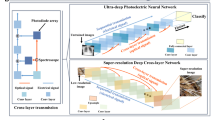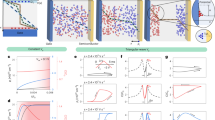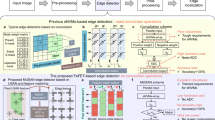Abstract
Edge devices face challenges when implementing deep neural networks due to constraints on their computational resources and power consumption. Fuzzy logic systems can potentially provide more efficient edge implementations due to their compactness and capacity to manage uncertain data. However, their hardware realization remains difficult, primarily because implementing reconfigurable membership function generators using conventional technologies requires high circuit complexity and power consumption. Here we report a multigate van der Waals interfacial junction transistor based on a molybdenum disulfide/graphene heterostructure that can generate tunable Gaussian-like and π-shaped membership functions. By integrating these generators with peripheral circuits, we create a reconfigurable fuzzy controller hardware capable of nonlinear system control. This fuzzy logic system can also be integrated with a few-layer convolution neural network to form a fuzzy neural network with enhanced performance in image segmentation.
This is a preview of subscription content, access via your institution
Access options
Access Nature and 54 other Nature Portfolio journals
Get Nature+, our best-value online-access subscription
$32.99 / 30 days
cancel any time
Subscribe to this journal
Receive 12 digital issues and online access to articles
$119.00 per year
only $9.92 per issue
Buy this article
- Purchase on SpringerLink
- Instant access to full article PDF
Prices may be subject to local taxes which are calculated during checkout





Similar content being viewed by others
Data availability
The data that support the findings of this study are available via the Harvard Dataverse repository at https://doi.org/10.7910/DVN/VBOVVW.
Code availability
The code used in this study is available via GitHub at https://github.com/hexu2333/Unet-with-Fuzzy-Layer.
References
Varghese, B., Wang, N., Barbhuiya, S., Kilpatrick, P. & Nikolopoulos, D. S. Challenges and opportunities in edge computing. In 2016 IEEE International Conference on Smart Cloud (SmartCloud) 20–26 (IEEE, 2016).
Shi, W., Cao, J., Zhang, Q., Li, Y. & Xu, L. Edge computing: vision and challenges. IEEE Internet Things J. 3, 637–646 (2016).
Mendel, J. M. Fuzzy logic systems for engineering: a tutorial. Proc. IEEE 83, 345–377 (1995).
van der Wal, A. J. Application of fuzzy logic control in industry. Fuzzy Sets Syst. 74, 33–41 (1995).
Hitzler, P. & Sarker, M. K. Neuro-Symbolic Artificial Intelligence: The State of the Art (IOS Press, 2022).
Baturone, I., Barriga, A., Jimenez-Fernandez, C., Lopez, D. R. & Sanchez-Solano, S. Microelectronic Design of Fuzzy Logic-Based Systems (CRC Press, 2018).
Peyravi, H., Khoei, A. & Hadidi, K. Design of an analog CMOS fuzzy logic controller chip. Fuzzy Sets Syst. 132, 245–260 (2002).
Wang, W.-z. & Jin, D.-m. Neuro-fuzzy system with high-speed low-power analog blocks. Fuzzy Sets Syst. 157, 2974–2982 (2006).
Baradaranrezaeii, A., Zarei, M., Khalilzadegan, A., Khoei, A. & Hadidi, K. A CMOS reference-less membership function generator. In 2011 19th Iranian Conference on Electrical Engineering 1–6 (IEEE, 2011).
Khalilzadegan, A., Khoei, A. & Hadidi, K. Circuit implementation of a fully programmable and continuously slope tunable triangular/trapezoidal membership function generator. Analog Integr. Circuits Signal Process. 71, 561–570 (2012).
Yaghmourali, Y. V., Fathi, A., Hassanzadazar, M., Khoei, A. & Hadidi, K. A low-power, fully programmable membership function generator using both transconductance and current modes. Fuzzy Sets Syst. 337, 128–142 (2018).
Jooq, M. K. Q., Behbahani, F., Al-Shidaifat, A., Khan, S. R. & Song, H. A high-performance and ultra-efficient fully programmable fuzzy membership function generator using FinFET technology for image enhancement. Int. J. Electron. Commun. 163, 154598 (2023).
Li, H. et al. Interfacial interactions in van der Waals heterostructures of MoS2 and graphene. ACS Nano 11, 11714–11723 (2017).
Johnson, M. A. & Moradi, M. H. PID Control (Springer, 2005).
Buckley, J. J. & Hayashi, Y. J. Fuzzy neural networks: a survey. Fuzzy Sets Syst. 66, 1–13 (1994).
de Campos Souza, P. V. Fuzzy neural networks and neuro-fuzzy networks: a review the main techniques and applications used in the literature. Appl. Soft Comput. 92, 106275 (2020).
Mak, K. F. et al. Tightly bound trions in monolayer MoS2. Nat. Mater. 12, 207–211 (2013).
Craciun, M. et al. Trilayer graphene is a semimetal with a gate-tunable band overlap. Nat. Nanotechnol. 4, 383–388 (2009).
Shih, C.-J. et al. Tuning on–off current ratio and field-effect mobility in a MoS2–graphene heterostructure via Schottky barrier modulation. ACS Nano 8, 5790–5798 (2014).
Lee, C.-H. et al. Atomically thin p–n junctions with van der Waals heterointerfaces. Nat. Nanotechnol. 9, 676–681 (2014).
Zhang, X. et al. Near-ideal van der Waals rectifiers based on all-two-dimensional Schottky junctions. Nat. Commun. 12, 1522 (2021).
Lee, H. S. et al. Metal semiconductor field-effect transistor with MoS2/conducting NiOx van der Waals Schottky interface for intrinsic high mobility and photoswitching speed. ACS Nano 9, 8312–8320 (2015).
Shin, H. G. et al. Vertical and in-plane current devices using NbS2/n-MoS2 van der Waals Schottky junction and graphene contact. Nano Lett. 18, 1937–1945 (2018).
Wang, J. et al. Transferred metal gate to 2D semiconductors for sub-1 V operation and near ideal subthreshold slope. Sci. Adv. 7, eabf8744 (2021).
Fu, J. et al. Photo‐driven semimetal–semiconductor field‐effect transistors. Adv. Opt. Mater. 11, 2201983 (2023).
Parker, A. E. & Skellern, D. J. A realistic large-signal MESFET model for SPICE. IEEE Trans. Microw. Theory Tech. 45, 1563–1571 (1997).
Ning, T. H. & Cai, J. On the performance and scaling of symmetric lateral bipolar transistors on SOI. IEEE J. Electron Devices Soc. 1, 21–27 (2013).
Mishra, S., Singh, V. K. & Pal, B. B. Effect of radiation and surface recombination on the characteristics of an ion-implanted GaAs MESFET. IEEE Trans. Electron Devices 37, 2–10 (1990).
Hájek, P. Metamathematics of Fuzzy Logic Vol. 4 (Springer, 2013).
Beck, M. E. et al. Spiking neurons from tunable Gaussian heterojunction transistors. Nat. Commun. 11, 1565 (2020).
Yan, X. et al. Reconfigurable mixed-kernel heterojunction transistors for personalized support vector machine classification. Nat. Electron. 6, 862–869 (2023).
Tang, K.-S., Man, K. F., Chen, G. & Kwong, S. An optimal fuzzy PID controller. IEEE Trans. Ind. Electron. 48, 757–765 (2001).
MacVicar-Whelan, P. Fuzzy sets for man–machine interaction. Int. J. Man Mach. Stud. 8, 687–697 (1976).
Mamdani, E. H. & Assilian, S. An experiment in linguistic synthesis with a fuzzy logic controller. Int. J. Man Mach. Stud. 7, 1–13 (1975).
Guo, S., Peters, L. & Surmann, H. Design and application of an analog fuzzy logic controller. IEEE Trans. Fuzzy Syst. 4, 429–438 (1996).
Ronneberger, O., Fischer, P. & Brox, T. U-Net: convolutional networks for biomedical image segmentation. In Medical Image Computing and Computer-Assisted Intervention—MICCAI 2015, Part III (eds Navab, N. et al.) 234–241 (Springer, 2015).
The Cityscapes Dataset; https://www.cityscapes-dataset.com/
Cordts, M. et al. The Cityscapes dataset for semantic urban scene understanding. In 2016 IEEE Conference on Computer Vision and Pattern Recognition (CVPR) 3213–3223 (IEEE, 2016).
Yang, J. J., Strukov, D. B. & Stewart, D. R. Memristive devices for computing. Nat. Nanotechnol. 8, 13–24 (2013).
Yao, P. et al. Fully hardware-implemented memristor convolutional neural network. Nature 577, 641–646 (2020).
Kim, M.-K., Kim, I.-J. & Lee, J.-S. CMOS-compatible compute-in-memory accelerators based on integrated ferroelectric synaptic arrays for convolution neural networks. Sci. Adv. 8, eabm8537 (2022).
Dorzhigulov, A., Choubey, B. & James, A. P. Current controlled neuro-fuzzy membership function generation. In 2018 IEEE 61st International Midwest Symposium on Circuits and Systems (MWSCAS) 929–932 (IEEE, 2019).
Azimi, S. & Miar-Naimi, H. Designing programmable current-mode Gaussian and bell-shaped membership function. Analog Integr. Circuits Signal Process. 102, 323–330 (2020).
Khaneshan, T. M., Nematzadeh, M., Khoei, A. & Hadidi, K. An analog reconfigurable Gaussian-shaped membership function generator using current-mode techniques. In 20th Iranian Conference on Electrical Engineering (ICEE2012) 145–149 (IEEE, 2012).
Lin, K.-J., Cheng, C.-J., Chiu, S.-F. & Su, H.-C. CMOS current-mode implementation of fractional-power functions. Circuits Syst. Signal Process. 31, 61–75 (2012).
Saatlo, A. N. & Ozoguz, S. CMOS implementation of scalable Morlet wavelet for application in signal processing. In 2015 38th International Conference on Telecommunications and Signal Processing (TSP) 1–4 (IEEE, 2015).
Khayatzadeh, R. & Yelten, M. B. A novel multiple membership function generator for fuzzy logic systems. In 2018 15th International Conference on Synthesis, Modeling, Analysis and Simulation Methods and Applications to Circuit Design (SMACD) 101–104 (IEEE, 2018).
Bozorgmehr, A., Jooq, M. K. Q., Moaiyeri, M. H., Navi, K. & Bagherzadeh, N. A high-performance fully programmable membership function generator based on 10 nm gate-all-around CNTFETs. Int. J. Electron. Commun. 123, 153293 (2020).
Ghasemian, H., Karami, S., Abiri, E. & Salehi, M. R. Design of a low power analog and multi-shaped fully programmable twin-cell membership function generator circuit in 65 nm CMOS technology. Circuits Syst. Signal Process. 40, 2–21 (2021).
Yan, X. et al. Reconfigurable stochastic neurons based on tin oxide/MoS2 hetero-memristors for simulated annealing and the Boltzmann machine. Nat. Commun. 12, 5710 (2021).
Acknowledgements
X.Y., J.H.Q. and M.C.H. acknowledge support from the US Department of Energy Office of Science ASCR and BES Microelectronics Threadwork Program (contract number DE-AC02-06CH11357) and the US National Science Foundation EFRI BRAID Program (contract number EFMA-2317974). N.Y. and J.G. acknowledge support from the US National Science Foundation (contract numbers 2203625 and 2007200).
Author information
Authors and Affiliations
Contributions
H.W., H.L. and J.W. conceived the project concept. H.W. supervised the entire project. H.W., H.L., J.W., J.M., X.Y. and M.C.H. designed the experiments and simulations. H.L., J.W., J.M., H.Z. and T.-H.H. fabricated the devices. H.L., J.W. and J.M. carried out the electrical measurements. N.Y. and J.G. carried out the device simulation. H.L., J.W., X.H. and Y.H. designed and carried out the FNN modelling. H.W., M.C.H., X.Y. and J.H.Q. participated in the experiments and data analysis. H.L., J.W. and H.W. co-wrote the paper. All authors discussed the results and provided inputs on the paper at all stages.
Corresponding authors
Ethics declarations
Competing interests
The authors declare no competing interests.
Peer review
Peer review information
Nature Electronics thanks Tao Liu and the other, anonymous, reviewer(s) for their contribution to the peer review of this work.
Additional information
Publisher’s note Springer Nature remains neutral with regard to jurisdictional claims in published maps and institutional affiliations.
Supplementary information
Supplementary Information
Supplementary Figs. 1–14, Notes 1–4 and Table 1.
Rights and permissions
Springer Nature or its licensor (e.g. a society or other partner) holds exclusive rights to this article under a publishing agreement with the author(s) or other rightsholder(s); author self-archiving of the accepted manuscript version of this article is solely governed by the terms of such publishing agreement and applicable law.
About this article
Cite this article
Liu, H., Wu, J., Ma, J. et al. A van der Waals interfacial junction transistor for reconfigurable fuzzy logic hardware. Nat Electron 7, 876–884 (2024). https://doi.org/10.1038/s41928-024-01256-3
Received:
Accepted:
Published:
Issue date:
DOI: https://doi.org/10.1038/s41928-024-01256-3
This article is cited by
-
Ambipolar two-dimensional materials-based reconfigurable devices
Science China Materials (2025)
-
Fuzzy logic with two-dimensional interfacial junction transistors
Nature Electronics (2024)



